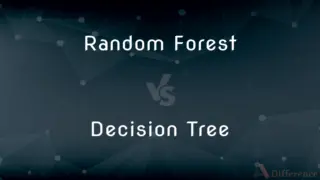Fusion 360 vs. Blender — What's the Difference?
By Tayyaba Rehman — Published on January 15, 2024
Fusion 360 is a cloud-based 3D modeling, CAD, CAM, and CAE software primarily for product design and manufacturing. Blender is an open-source 3D graphics software for animation, modeling, rendering, and visual effects.

Difference Between Fusion 360 and Blender
Table of Contents
ADVERTISEMENT
Key Differences
Fusion 360, developed by Autodesk, is designed for professional use in engineering, product design, and manufacturing. It offers an integrated approach to product development combining CAD, CAM, and CAE tools. Blender is more versatile, targeting a broader range of 3D creation, including animation, visual effects, art, and game development.
Fusion 360 provides features for parametric modeling, simulation, and collaboration in cloud-based projects. It's highly valued in the mechanical engineering and industrial design sectors for its precision and professional-grade tools. In contrast, Blender excels in artistic modeling and animation, with strong capabilities in texturing, particle simulation, and video editing.
The user base of Fusion 360 primarily consists of professionals in engineering and design fields, due to its specialized tools for product development and manufacturing processes. Blender, being free and open-source, attracts a wide range of users from hobbyists to professionals in the film and gaming industries.
Fusion 360 operates on a subscription model, offering different tiers for users ranging from students to large enterprises. Blender is entirely free, with no subscription or licensing fees, making it accessible to anyone interested in 3D creation.
While Fusion 360 is focused on the practical aspects of design and manufacturing, including precise measurements and material properties, Blender offers more flexibility in creative and artistic projects, with robust tools for animation and rendering.
ADVERTISEMENT
Comparison Chart
Primary Use
CAD/CAM/CAE for product design and manufacturing.
3D graphics for animation, modeling, and visual effects.
Target User Base
Engineers, designers in professional sectors.
Broad range, from hobbyists to film/game professionals.
Software Features
Parametric modeling, simulation, manufacturing.
Animation, rendering, texturing, video editing.
Pricing Model
Subscription-based.
Completely free and open-source.
Strengths
Precision, engineering-focused tools.
Versatility in creative and artistic 3D projects.
Compare with Definitions
Fusion 360
Cloud-based software for professional engineering and manufacturing.
Our team collaboratively worked on the mechanical design using Fusion 360.
Blender
A free, open-source 3D graphics software for animation and modeling.
I created an animated short film using Blender.
Fusion 360
Offers integrated tools for 3D modeling and manufacturing processes.
Fusion 360 streamlined our product's prototyping phase.
Blender
Widely used for 3D rendering, visual effects, and game development.
We developed our game's characters and environments in Blender.
Fusion 360
Suitable for detailed, precise product and mechanical designs.
Fusion 360 was essential for accurate 3D modeling of the machine parts.
Blender
Known for its versatility in various forms of 3D creation.
Blender was perfect for creating both the visual effects and the 3D assets for our project.
Fusion 360
Developed by Autodesk, focusing on industrial applications.
For our manufacturing project, Fusion 360's CAM capabilities were invaluable.
Blender
Popular among hobbyists and professionals in the creative industry.
As a freelance artist, I rely on Blender for my 3D artwork.
Fusion 360
A comprehensive CAD, CAM, and CAE software for product design.
We used Fusion 360 for the complete design and simulation of our new product.
Blender
Offers extensive tools for artistic modeling, texturing, and video editing.
Blender's texturing tools helped me add realistic details to my 3D models.
Common Curiosities
What is Blender primarily used for?
For creating 3D graphics, including animation, modeling, and visual effects.
Can Blender be used professionally?
Yes, it's used by professionals in the film, animation, and game development industries.
What is Fusion 360 best used for?
Ideal for professional CAD, CAM, and CAE applications in product design and manufacturing.
Is Blender as precise as Fusion 360 for engineering designs?
Blender is not primarily geared towards engineering precision like Fusion 360.
Does Fusion 360 require an internet connection?
Being cloud-based, it requires internet for full functionality, but it offers offline capabilities as well.
Is Fusion 360 free to use?
No, it operates on a subscription model, though it offers free licenses for students and educators.
Does Fusion 360 offer animation tools?
Its primary focus is on product design and manufacturing, not on animation.
Is Blender good for beginners in 3D modeling?
It has a steep learning curve but is popular among beginners due to its free access and strong community support.
Can Fusion 360 be used for 3D printing?
Yes, it offers tools for designing and preparing models for 3D printing.
Is Fusion 360 suitable for architectural design?
While possible, it's more tailored for product and mechanical design.
Does Blender support simulation like Fusion 360?
Blender supports basic physics simulations, but not engineering simulations like Fusion 360.
Are there any cost-effective alternatives to Fusion 360?
Blender can be an alternative for 3D modeling, but for CAD specific tasks, other alternatives like FreeCAD can be considered.
Can Blender be used in educational settings?
Yes, it's widely used in education due to its free nature and comprehensive features.
Which software is better for a small business in product development?
Fusion 360, due to its specialized tools for product design and manufacturing.
Can Fusion 360 handle animation and game development?
Its capabilities are limited in these areas compared to Blender.
Share Your Discovery

Previous Comparison
Random Forest vs. Decision Tree
Next Comparison
Block Cipher vs. Stream CipherAuthor Spotlight
Written by
Tayyaba RehmanTayyaba Rehman is a distinguished writer, currently serving as a primary contributor to askdifference.com. As a researcher in semantics and etymology, Tayyaba's passion for the complexity of languages and their distinctions has found a perfect home on the platform. Tayyaba delves into the intricacies of language, distinguishing between commonly confused words and phrases, thereby providing clarity for readers worldwide.














































